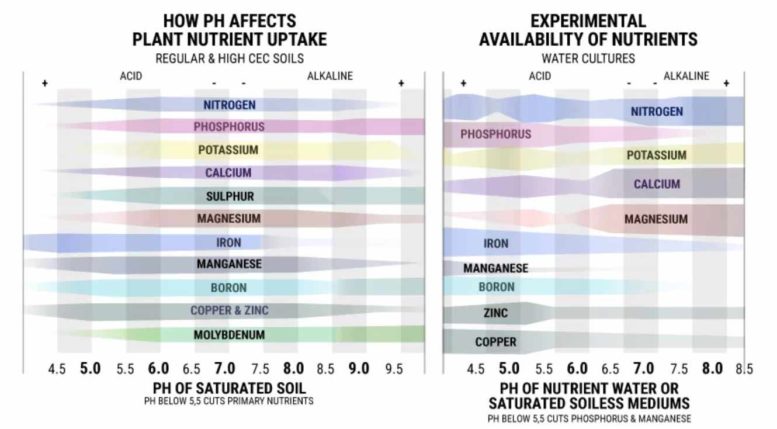- Your cart is empty
- Continue Shopping
The perfect PH value for a cannabis plant
The perfect PH value for a cannabis plant
In the world of gardening, pH both affects and is affected by everything. Indeed, the entire process of growing plants is a study in the physical dance of pH balance.
So, you are on your way to growing great cannabis. Your seeds have sprouted, and a small cannabis plant is now eagerly growing. You have spent good money on quality nutrients, and have made sure to properly water and feed your precious plant baby. But something is wrong; you notice your plant appears sick. The leaves are getting discoloured and growth has come to a standstill. Before you know it, your plant is withering away, and you’re stumped as to how this could’ve possibly happened.
Among fatal flaws like overwatering and overfeeding, pH imbalances are one of the most common issues in the cannabis garden. To understand why pH is so important, let us first understand the concept in and of itself.
WHAT IS PH?
pH is a measure of how acidic or alkaline something is. The pH scale ranges from 1–14, with a pH of 7 being neutral (the pH of pure water). If pH is lower than 7, a substance is considered acidic (think vinegar or lemon juice). If the pH is higher than 7, the substance is alkaline, as is the case with soaps, bleach, and ammonia.
In more scientific terms, pH level has to do with the concentration of hydrogen ions, say in the water you give to your plants. The pH scale is logarithmic to the base 10, which means that water with a pH of 6 is already 10x more acidic than water with a pH of 7.

WHY IS PH IMPORTANT WHEN GROWING CANNABIS?
As you will already know, all plants require nutrients for healthy growth. They require macronutrients nitrogen, phosphorus, and potassium, as well as micronutrients and minerals including calcium, magnesium, iron, copper, and a whole lot more. If plants cannot access these nutrients, it will lead to deficiencies and other serious health problems.
The issue with cannabis plants is that they are only able to take up nutrients within a small pH window, which ranges from about 6–7 when growing in soil. If the pH is lower or higher than that, the plant cannot take in nutrients, even if they are present—thus spurring nutrient deficiencies via “nutrient lockout”.
In those places where cannabis thrives in the wild, the soil is normally slightly acidic; therefore, homegrown cannabis plants will also prefer a slightly acidic environment. However, the way that you grow cannabis also plays a role in the optimal pH level for your plants. Cannabis grown hydroponically or without soil needs an even lower pH than a soil grow.
WHAT’S THE BEST PH FOR GROWING CANNABIS?
SOIL: 6.0–7.0 pH
If you grow in soil, the optimal pH level for the root zone is between 6.0 and 7.0. However, there is no set number within this range that is “best”. Instead, it can be good to allow for some natural fluctuation within this window to support optimal nutrient uptake. So as you adjust, try a slightly different reading each time. You can, for example, adjust your pH to 6.2 for one watering, then 6.6 the next. As long as it stays within 6.0–7.0, you should be fine. Soil is also more forgiving when it comes to pH imbalances, but it can only give so much.
If you grow purely organically—where you do not administer liquid nutrients—pH is less of an issue. If you’re using amended and composted soil with organic matter, the microorganisms within will make the nutrients more available to the roots. However, most growers using standard potting mixes and liquid nutrients will indeed have to reckon with pH.
HYDROPONICS AND SOIL-LESS: 5.7–6.3 pH
Hydro and soil-less grows are a different beast when it comes to pH. If you grow soil-less, say in coco, the optimal pH level at the root zone should be somewhat lower than in soil, between 5.5–6.5. The same goes for all methods of hydro.
With these methods, it is just as important that you allow the pH level to fluctuate across the acceptable range to support nutrient uptake. For example, in hydro, calcium and magnesium are mostly absorbed at pH levels above 6, while other nutrients like manganese prefer a slightly lower pH.
Then again, this shouldn’t be an issue since pH levels will naturally change slightly with each feeding in a hydroponic setup. You will only need to correct if the pH level exits the optimal 5.5–6.5 pH range.
When growing in coco, perlite, or hydroponically, you are in charge of administering nutrients directly to the root zone via the water, which means that huge pH fluctuations are more of a risk than in soil. The inert media used in hydro and soil-less grows merely retains water and provides support for the roots of your plants. So when administering nutrients, be careful that you don’t overload your plants.
HOW TO TEST PH
Managing pH level means testing the water or nutrient solution and adjusting it accordingly. This may sound complicated, but it really isn’t.
To test pH, you can use a digital pH meter, or a pH measurement kit with drops. Opinions here differ as to which method is “best”. Some prefer digital pH meters because they are accurate and easy to read, while others like the drops as they are super simple and don’t require calibration. Try them both and see which you prefer.
Measure the pH after you add any nutrients or amendments as they will change the pH value of your water. After you mix the solution, use the pH meter or drops to test the pH level. If you are growing hydroponically, test a sample from your water reservoir a few minutes after you add your nutrients.
HOW TO ADJUST PH
If the pH is out of the optimal range for your growing setup, it’s crucial you correct it. This can be done using “pH up” and “pH down” products, which you can obtain at any grow store. If your pH is too high, you will of course need to add some pH down, and vice versa.
Given the alkalinity of most tap water, most of the time you will probably need to lower your pH as opposed to raising it. This means you could potentially get by with just a bottle of pH down. Note that you will normally need very small amounts of these pH-adjusting products to see results. Add the required amount and then test your water with the meter or drops. When everything is in the clear, you can feed your plants.
Also keep in mind that changes in season and other factors affect the pH of your tap water. This means you shouldn’t assume that your nutrient solution is consistent with every feeding; instead, check it occasionally to make sure things are still as they should be.
for more info on PH PPM Impact click here
Tags: Cannabis PH, Importance of PH, perfect PH, PH Cannabis